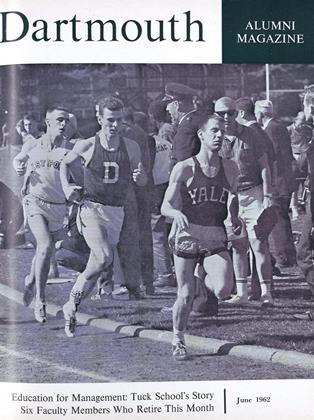JUST five months from now Dartmouth's eagerly awaited facility to accommodate all programs in the creative and performing arts will become a reality when the Hopkins Center opens in .November for student, faculty, alumni and community use. • In nearly two hundred years of history, Dartmouth has never had - with the possible exception of Baker Library - a more significant plant addition, nor one which has created such great enthusiasm and excitement among planners, architects, builders and teachers at colleges across the nation. • Here in four connected and related buildings will be housed the theatres, lecture halls, studios, workshops, art galleries, music rooms, lounges, and Alumni Hall which will add a needed and imaginative dimension to the College's program. • Dartmouth is matching the first-rate facilities of the Hopkins Center with first-rate teachers and artists: Warner Bentley, John Stewart, and John Scotford, who will administer the Center; Henry Williams, George Schoenhut, and George Tuttle in the theatre programs; artists Paul Sample and Richard Wagner; sculptor Winslow Eaves; James Sykes, Paul Zeller, Donald Wendlandt, and Milton Gill in the music department; Ray Nash in graphic arts; Edgar Hunter in architecture; Virgil Poling, heading the student workshop program. • This spring further strength was added to the Hopkins Center teaching staff with the appointments of Mario di Bonaventura, a distinguished composer, performer and conductor, as director of the Center's music program; and Professor James Clancy of Stanford, a nationally respected dramatic director and theatre scholar, who will be in charge of the Center's theatres. • To assure programs of comparable quality for the Center, faculty committees have met frequently for more than a year to study and plan the opportunities and offerings in the arts. These are ambitious programs, carefully and imaginatively designed to enrich undergraduate education by relating the performing and creative arts to each other and to the academic programs of the College. Students will be offered a variety of cultural experiences ranging from personal contact with visiting artists and their individual creative efforts, to the dynamic interplay of group creativity in drama and music. Programs of concerts, lectures, drama, and exhibits will offer daily inducements to undergraduates to sample and savor the richness of the cultural heritage that is theirs for the taking. • Some of the programs moving into the Hopkins Center this fall are already financed. These existing programs can be greatly enriched as the new facilities and new teacher-artists cast their influence upon them. The Center also will provide unparalleled opportunities to experiment with and create new program offerings in the arts, particularly in response to the enthusiasm and creativity which the Dartmouth undergraduates will generate. The expansion of current offerings and establishment of new ones, however, will require new funds, and just how effectively such programs can be carried forward depends heavily on additional financing. Here is an immediate area where the Alumni Fund can be of significant assistance. • By allocating a portion of our Fund proceeds for Hopkins Center programs in 1962-63, the Fund Committee seeks to further the quality growth of the College. Alumni have an opportunity this spring to assist with the new program strength for a Hopkins Center whic for generations to come will serve Dartmouth and our society well.
THE ALUMNI FUND COMMITTEE
(This message from the Fund Committee, dated June 1, is reproduced for those alumni who did not receive it because they had already contributed.J
 View Full Issue
View Full Issue
More From This Issue
-
 Feature
FeatureDays of Controversy: 1816-1819
June 1962 -
 Feature
FeatureEducation for Management
June 1962 By CARLA A. SYKES -
 Feature
FeatureA College-Church Partnership
June 1962 By CLIFF JORDAN '45 -
 Feature
FeatureSix Faculty Members to Retire
June 1962 -
 Feature
FeaturePsychologists Discuss World Tensions in a Conference Dedicating Gerry Hall
June 1962 -
 Class Notes
Class Notes1931
June 1962 By WILLARD C.WOLFF, WILLIAM T. WENDELL







